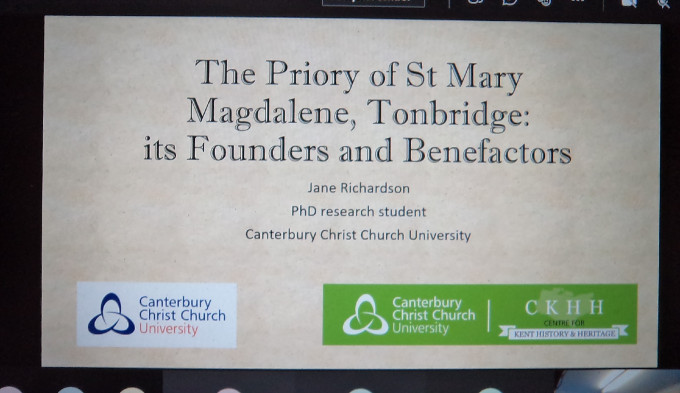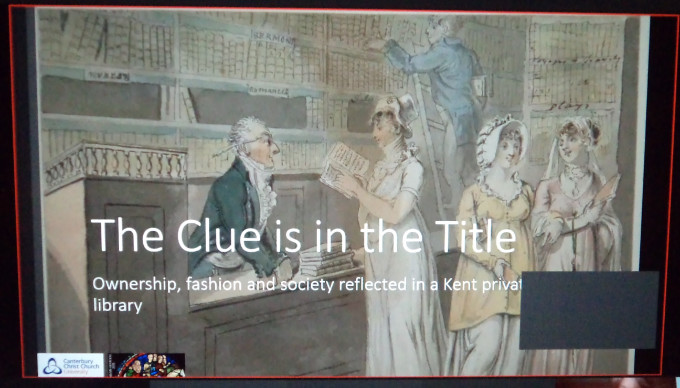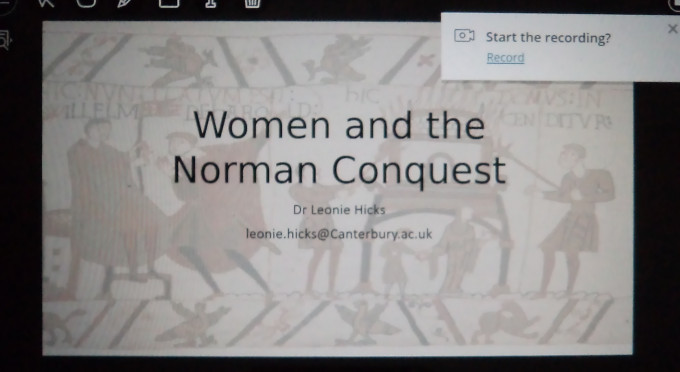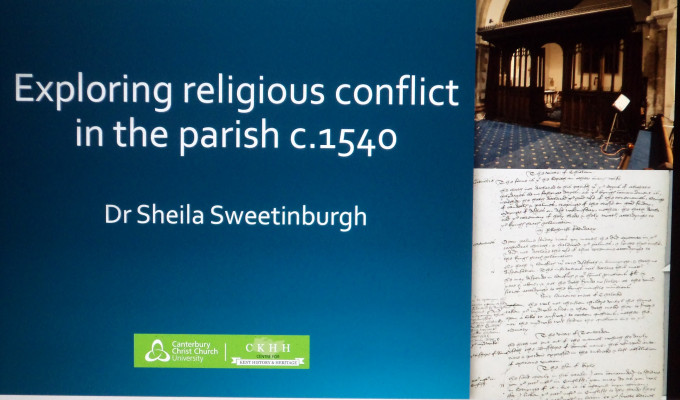Stop press, calling all schools – do you want to design a Thomas Becket giant? Now is a great opportunity, but you need to be quick because the deadline is 1 July!! Here is the link to the competition pack with the necessary details: https://www.canterburybid.co.uk/canterbury-medieval-pageant/ For the KS1&2 version, please contact: Rachel Pilard: rachel.pilard@canterburybid.co.uk who has the details.

Keeping on the topic of news, Dr Claire Bartram has been busy finalising the series of talks to be given by members of the Faculty of Arts, Humanities and Education as part of the Canterbury Festival because the Festival programme will be going to press very shortly. There will be a wide range of speakers and topics from archaeology and green heritage to creative writing and education, so please watch out for more details. Claire has also been busy organising the planning meeting down at Dover in early July for those involved in the exciting IHR Centenary funded project concerning the town under the IHR’s banner – Our Century: thinking back, looking forward, so more on this as soon as we have met.
The Centre’s final event of this academic year up to the end of July will be an online lecture on Teams Live Event on Tuesday 20 July at 7pm when Dr Ben Marsh from the University of Kent will explore ‘Gateways to Empire: Figuring Out Kent’s Black Histories, c.1550-1800’. As he says, “In this paper I will present some of the insights from my co-authored chapter with Professor David Killingray about racial diversity across maritime Kent. My talk will consider how Kent operated as a gateway for imperial expansionism from the late sixteenth century, and how economic and social links brought new populations and opportunities to communities. Drawing on ongoing research into the arms of the Juxon family, I will also reflect on how commerce and familiarity were mapped onto structures of power, prestige, and the built environment.” This sounds a fascinating topic and as a free, public lecture, please do save the date and time, booking is not necessary and the link will be available in the blog nearer the time and on the CCCU and Centre’s Future Events webpages – again, please watch this space!!

Keeping with the maritime Kent theme, I thought I would just let you know that the proofs for the volume Maritime Kent through the Ages: Gateway to the Sea have now arrived and have gone out to contributors. As well as dealing with any issues raised from these, the editors are also starting on the index which is quite a task because this is a heavyweight volume in several senses! Nevertheless, this is an exciting time, and it will be brilliant to see it come to fruition, not least because it includes contributions from current and former staff members from two CCCU Faculties.
Moving inland, as some of you who follow Claire Bartram on twitter will have noticed, she was out walking in Blean Woods last week with several colleagues, including Professor Carolyn Oulton, as part of Dr Sam Vale’s mini research project. His idea is to walk in company in Blean Woods and then make an outcome based or drawn from this collective experience. Thus, the project will act as a kind of chart of the wood through different disciplines: writing, art, music, poetry, history and of course photography, Sam’s own specialism. Now this week I’ll be joining Sam and Dr Diane Heath, her daughter Helena and Diane’s dog to see walk in another part of the woodland, again more anon.
A potential link to this walk is woodland and hedgerow plants, which came into my series of mini-lectures for ‘The Church and Medieval Medicine’ as part of the GCSE materials for the History of Medicine course. Creating these mini-lectures was an interesting challenge, and by focusing on five major topics, I was able to move from medieval ideas about the soul and the body as taught by the Church in Western Christendom, and how this affected the ways people were expected to act when confronted by illness and death through to some of the fringe areas which worried at least some churchmen who envisaged medical practitioners straying into the dark arts. Along the way we examined Christus Medicus, the role of pilgrimage and hospitals, ideas about prevention as well as treatment, and just who were the medical practitioners in this period. All in all, it was certainly an interesting experience.

Going back to the end of last week, it was great to be part not only of the 25th birthday celebration of MEMS at the University of Kent, but also to be involved in the annual MEMS postgraduate-organised MEMS Fest. Like last year, this was again online and was even bigger, running for three days. On the Friday, the middle day, it gave me great pleasure to chair the ‘Exploring Historical Kent’ session that included two from amongst the CCCU Kent History Postgraduates: Jane Richardson and Victoria Stevens. They were joined by Christopher Moore, from MEMS at Kent. This was an excellent opportunity to showcase not only the great research being undertaken by CCCU postgraduates working on Kent topics, but to highlight the richness, depth and range of topics, approaches and primary sources available across all time periods. As the filling in the sandwich, Christopher explored the history, significance and conservation of the ‘Castles of the Downs’: Walmer, Deal and Sandown. For even though they were built within a very narrow time frame (between 1539 and 1540) as defensive measures against the threat of invasion from the French following Henry VIII’s breakaway from Rome, were constructed by the same builders, and were connected by a series of defensive trenches known as ‘bulwarks’, their ultimate fate varied tremendously. As Christopher explained, looking at their early lives, the three benefitted from a blueprint that was unique to England for this period, the idea being that they were as much offensive as they were defensive regarding the arrangement of their armament. However, their ascendancy and prominence were short-lived, and within a few decades they were broadly ignored as things moved on, and several centuries later Sandown had almost all gone – its stone is now in other buildings dotted across east Kent, while Deal was the closest to a working military installation and Walmer had become the desirable residence of the Warden of the Cinque Ports.

Now to what makes it a sandwich, Jane began the session by investigating the founders and benefactors of Tonbridge Priory, one of her three religious houses in Kent that Cardinal Wolsey appropriated to establish and maintain his new Cardinal College at Oxford and his grammar school at Ipswich. The other two Kent houses were Lesnes Abbey and Bayham Abbey. It is worth noting that he had even grander, more expansionist plans to introduce grammar education across far more towns and cities, but his enemies and Henry VIII got to him first.
For Tonbridge Priory, Jane took her audience back to the 12th century and the detective work she has been doing to decide which member of the de Clare family was the priory’s founder. Using the earliest surviving documentation, she has concluded that the founder was Richard de Clare who established the priory c.1180, and even though trying to assign motivation is extraordinarily difficult, it could relate in part to an unfulfilled vow about going on crusade, it may also relate to the desire to be buried in the abbey church. The funeral monument would have been fitting for such a man who needed to proclaim his family’s position regarding their status, wealth and influence locally and as one of those families who had been among William I’s trusted companions.

Such influence regarding familial piety may similarly have extended to the local knightly families in the vicinity of Tonbridge, and, as regular readers of the blog will know, one such family that Jane has been working on recently are the Culpepers. Consequently, in the second section of her presentation Jane examined their activities as benefactors in the 14th and 15th centuries not just of Tonbridge Priory but also of Bayham Abbey, such reciprocal gift-giving placing them within west Kent’s spiritual economy.
As the final speaker, Victoria Stevens took the audience to east Kent and the country house library of a yeoman family from the 15th century who had risen up the social hierarchy through their successes as farmers, land holders, bankers, the law and a series of marriages with members from other country gentry families in the region. As the long-time holders of St Albans Court in Nonington, they had expanded and then rebuilt the house, giving fitting predominance as they saw it to their library for which they probably began collecting in the 16th century, or possibly even before. Not that the library catalogue includes such potential manuscripts or very early printed books, but it does reveal much about the professional and leisure interests of several generations of the family.
Again, as regular readers of the blog will know this is another fascinating research area and Victoria, as one of the lines of her research, is exploring the possibility that some of the library’s books with their book plates have survived. Furthermore, having married into the Oxenden family, this connection may lead to books from the library, or at least similar volumes being still in east Kent because this family’s collection became the Elham parish library, which is today in Canterbury Cathedral library collections.

All three excellent papers generated considerable interest among the sizeable audience and the consequent audience questions took the session five minutes over the allotted time. Thus, I should like to thank all three speakers for an exciting and diverse session, showing the potential not only of the research topics available that the quality of the surviving primary sources available in Kent, London and Oxford.
I thought I would finish off this week by mentioning the virtual History Garden Party organised by Lizzie Burton of Education and PGCE teacher training and Dr Simon Prince, a modern historian who specialises in Irish history. This online event for trainee teachers, their mentors, other staff members from Education and History, postgraduates and final year undergraduates interested in becoming teachers. As Simon said in his presentation on imperial history, recent developments in university teaching are seeing a move away from national histories towards the global, bringing in the human perspective that highlights fluidity, diversity and inclusivity, and the dynamic movement of people, goods and ideas spatially and over time. His presentation sparked several interesting questions, including which country’s history might make a good case study for schools to explore these ideas, Simon’s answer being New Zealand.

Dr Leonie Hicks, a Norman specialist, followed Simon, exploring women and the Norman Conquest, which as she explained meant going earlier in time to look at the implications of the earlier conquest by Cnut because this had major ramifications for the first of her women, Queen Emma. Having provided some fascinating case studies of these queens and other royal women, Leonie in response to the subsequent audience questions noted that current scholarship is moving away from denoting them as exceptional women. Rather there is the realisation that this was the norm, this was how women were expected and needed to operate for the benefit of their families, such soft power vital for the success of these dynasties.
For the final presentation I took the audience to the other alternative to Simon’s global history – the local, or at least the regional, as a means to explore networks and agency among ordinary people, what was at one time known as ‘history from below’. For by using the depositions collected by Archbishop Cranmer in 1543 in response to the Prebendaries’ Plot against him we can gain insights into people’s responses to the religious changes by those who embraced the innovations, those who tried to stop them and those who aimed to survive them while keeping their faith intact. Using as an example John Tofts’ reading of the Bible in English in a loud voice to his audience of known women in St Mary Northgate parish church in Canterbury, I showed how students can think about place, timing, objects, performance, primary and secondary audiences and relationships among the actors. The subsequent discussion considered how such evidence might be employed by Year 8s and others below the major exam cohorts, and one way is I think is through dramatizing these events using the depositions to explore emotional responses.

This might be seen as bringing us back to Sam Vale’s research project and responses to the walk this week in Blean Woods.
 Centre for Kent History and Heritage
Centre for Kent History and Heritage Sheila Sweetinburgh
Sheila Sweetinburgh 1512
1512

